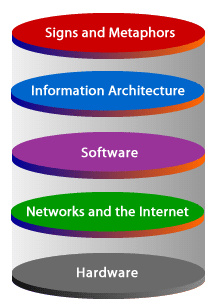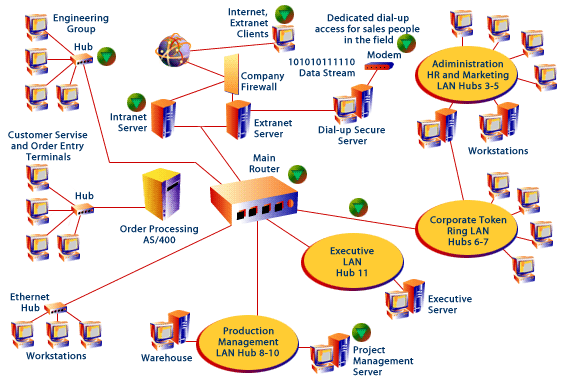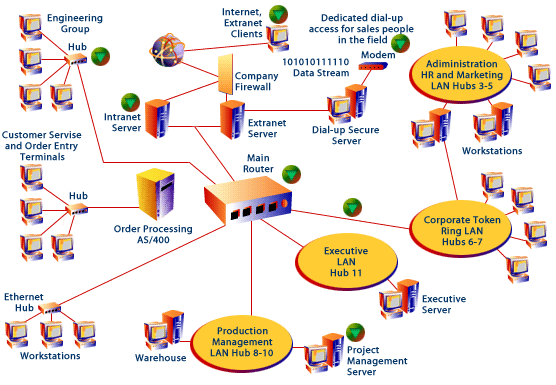| Lesson 5 | Hardware |
| Objective | Describe the Components of the Hardware Layer. |
Components of Hardware Layer
The fifth layer of the Web Interaction Model is Hardware. Hardware consists of the physical components of Web interaction, from back-end equipment such as a UNIX server for storing the Web site's supporting database; to dial-up or dedicated data connection lines; to the
Internet backbone through which the information is transmitted; to the end user's PC, where the information is requested and
accessed. The following section contains a diagram of the hardware layer .
Networks, Internet layer and the Web Interaction Model

| Signs and Metaphors | Images, icons, colors, sounds, implied comparisons. |
| Information Architecture | Structure, navigation |
| Software | Software combines function and design, allowing the user to view and interact with the first two layers. Software includes languages, applications, databases, and bundled software solutions. |
| Networks and the internet | Public (Internet), private (intranet, extranet), protocols, addresses |
Intranets Defined
An intranet is defined by the use of Internet technologies (HTTP, TCP/IP, FTP, SMTP) within an organization.
By contrast, the Internet is a global network of machines connecting different organizations.
The line becomes blurred when the internal system is opened to remote access and parts of the system are made available to customers
and suppliers. This extension of an intranet to selected outsiders is often called an extranet.
As networks continue to develop, distinctions among types of systems will become increasingly artificial , just as the once clear distinctions among hardware such as personal computers, servers, and minicomputers have lost meaning.
When studying network architectures, concentrate on how the issues described may affect internet technology-based systems within your organizations, rather than on the specific definition of any one system.
Because they are based on open Internet standards, intranets are easy to implement technologically. Although they can offer robust functionality with little investment, they are often rolled out with little forethought and therefore fail to make a significant contribution to the organization.
Much of the research and background information applicable to intranets is now being published in other areas. The technological issues overlap with the broader Internet, and many of the internal applications offered on intranets are now encompassed by enterprise applications and knowledge management. Some authors even refer to (B2E) business-to-employee applications emphasizing the importance of focusing on the access to systems by those within the organization.
Because they are based on open Internet standards, intranets are easy to implement technologically. Although they can offer robust functionality with little investment, they are often rolled out with little forethought and therefore fail to make a significant contribution to the organization.
Much of the research and background information applicable to intranets is now being published in other areas. The technological issues overlap with the broader Internet, and many of the internal applications offered on intranets are now encompassed by enterprise applications and knowledge management. Some authors even refer to (B2E) business-to-employee applications emphasizing the importance of focusing on the access to systems by those within the organization.
Web Interaction Model,
In the Web Interaction Model, networks and hardware are separated to help articulate how the Web works and to conceptualize Web site requirements. Keep in mind that every network uses hardware to operate. Networks are made up of hardware plus the systems for identifying components and regulating traffic flow. To build on the familiar Information Superhighway metaphor, networks can be seen as the highway
system, while hardware can be seen as the physical roads, bridges, and entry ramps of the highway system. Hardware creates the physical platform for the Internet to function. The following diagram describes some of the basic hardware and connectivity components that are necessary for Web implementations:

| Engineering Group, Hub: | Interconnects multiple devices in a network, thereby enabling distribution of information among the devices connected to it. |
| Intranet Server: | The server stores and forwards URLs and resources (such as Web pages, images, other data). |
| Internet, Extranet Clients: | Client [CPU, hard drive, monitor] - The client hosts the browser that allows users to access and display Web resources. |
| Dial access (Sales People) Modem: | Used when dial-up services are necessary. When analog telephone lines are used to access the Internet, a modem converts digital to analog signals (outgoing traffic) and from analog to digital (incoming traffic). DSU/CSU modems are used for T1 or fractional lines. Digital modems do not need to convert from digital to analog, but maintain digital from end to end (for example, for use with ISDN or ADSL lines). |
| Main Router: | Connects two or more IP networks and routes traffic based on IP addresses. |
| Physcial Connections, Connectivity: | The physical connections among network hardware, such as cables, phone lines, or other connection lines. A primary connectivity issue is bandwidth, which is the maximum amount of information that the line can transmit per unit of time. (Home computers often connect via telephone lines, while businesses usually use connections with greater bandwidth, such as T1 lines, ISDN lines, or DSL.) |
| Project Management Server: | The server is a computer that is dedicated to storing data or running applications, processes, and services. |
Hardware Components of the Web

| Client (CPU, hard drive, and monitor) | The client hosts the browser that allows users to access and display Web resources. |
| Server | The server is a computer that is dedicated to storing data or running applications, processes, and services. |
| Web Server | The server stores and forwards URLs and resources (such as Web pages, images, other data). |
| Connectivity | The physical connections among network hardware, such as cables, phone lines, or other connection lines. A primary connectivity issue is bandwidth, which is the maximum amount of information that the line can transmit per unit of time. (Home computers often connect via telephone lines, while businesses usually use connections with greater bandwidth, such as T1 lines, ISDN lines, or DSL.) |
| Router | Connects two or more IP networks and routes traffic based on IP addresses. |
| Hub | Interconnects multiple devices in a network, thereby enabling distribution of information among the devices connected to it. |
| Modem | Used when dial-up services are necessary. When analog telephone lines are used to access the Internet, a modem converts digital to analog signals (outgoing traffic) and from analog to digital (incoming traffic). DSU/CSU modems are used for T1 or fractional lines. Digital modems do not need to convert from digital to analog, but maintain digital from end to end (for example, for use with ISDN or ADSL lines). |
In the next lesson, you will see how all five Web layers interact in a real-time transaction. You will use the Web Interaction Model to explain how resources are requested and received via the Web.
Web Interaction Model Elements
Click the link below to identify where in the model various elements of the Web belong.
Web Interaction Model Elements
Web Interaction Model Elements
Ad Build Next Generation Digital Workplace